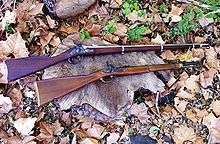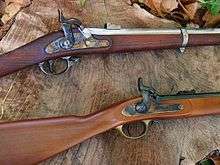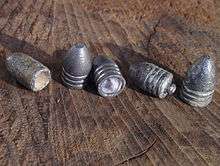Springfield Model 1861
| Model 1861 Rifle-Boy | |
|---|---|
 | |
| Type | Rifle musket |
| Place of origin | United States |
| Service history | |
| In service | 1861–72 |
| Used by |
United States Confederate States of America |
| Wars |
American Civil War American Indian Wars |
| Production history | |
| Designed | 1861 |
| Produced | 1861–72 |
| Number built | ~1,000,000 |
| Specifications | |
| Weight | 9 pounds (4.1 kg) |
| Length | 56 inches (1,400 mm) |
|
| |
| Cartridge | .58 Minié ball |
| Caliber | .58 inches (15 mm) |
| Action | Percussion lock |
| Rate of fire | 2–4 round/min |
| Effective firing range | 100 to 400 yards (91 to 366 m) |
| Maximum firing range | 500 to 620 yards (460 to 570 m) |
| Feed system | Muzzle-loaded |




The Springfield Model 1861 was a Minié-type rifled musket shoulder-arm used by the United States Army and Marine Corps during the American Civil War. Commonly referred to as the "Springfield" (after its original place of production, Springfield, Massachusetts),[1] it was the most widely used U.S. Army weapon during the Civil War, favored for its range, accuracy, and reliability.
Overview
The barrel was 40 inches long, firing a .58 caliber Minié ball, and the total weight was approximately 9 pounds. The Springfield had a general effective range of 200 to 300 yards but could reliably hit man sized targets out to 500 yards when used by marksmen, and used percussion caps to fire (rather than the flintlocks of the 18th century, the last U.S. flintlock musket was the Model 1840). Well-trained troops were able to fire at a rate of three aimed shots per minute while maintaining accuracy up to 500 yards, though firing distances in the war were often much shorter.[1] The most notable difference between the Model 1861 and the earlier Model 1855 was the elimination of the Maynard tape primer for the Model 1861 (the Maynard primer, a self-feeding primer system, was unreliable in damp weather, and the priming mechanism was expensive and time-consuming to produce). Further, unlike the Model 1855, the Model 1861 was never produced in a two-banded "rifle" configuration.
The Springfield was aimed using flip-up leaf sights. The sight had two leaves, one for 300 yards and the other for 500 yards, and with both leaves down, the sight was set for a range of 100 yards. By contrast, the British Pattern 1853 Enfield, favored by the Confederates, utilized a ladder-sight system with 100 yard increments, using steps from 100 to 400 yards and a flip up ladder for ranges beyond 500 yards. While the Enfield's sights did allow finer range settings, the Springfield's simple leaves were more rugged and were less expensive to produce. The Enfield's sights extended to 900 yards (and further, on later models), compared to the 500 yard maximum range of the Springfield's sights. Realistically, though, hitting anything beyond 600 yards with either weapon was mostly a matter of luck. While the sight designs were very different, the two weapons were otherwise very similar, and had very similar effective ranges.
The Springfield Rifle cost $20 each at the Springfield Armory where they were officially made. Overwhelmed by the demand, the armory opened its weapons patterns up to twenty private contractors. The most notable producer of contract Model 1861 Springfields was Colt, who made several minor design changes in their version, the "Colt Special" rifled musket. These changes included redesigned barrel bands, a new hammer, and a redesigned bolster. Several of these changes were eventually adopted by the Ordnance Department and incorporated into the Model 1863 rifled musket.
The Springfield Model 1861 was equipped with a square socket bayonet.
History
The Model 1861 was relatively scarce in the early years of the Civil War (many troops were still using Model 1842 smoothbored muskets and Model 1816/1822 muskets converted to percussion cap primers, both in .69 caliber). It is unlikely that any of these were available for use in the First Battle of Bull Run. However, over time, more and more regiments began receiving Model 1861 rifled muskets, though this upgrade appeared somewhat quicker in the Eastern Theater of Operations. Over 1,000,000 Model 1861 rifles were produced, with the Springfield Armory increasing its production during the war by contracting out to twenty other firms in the Union.[1] The number of Model 1861 muskets produced by the Springfield Armory was 265,129 between January 1, 1861 and December 31, 1863. According to United States Muskets, Rifles and Carbines by Arcadi Gluckman Colonel Infantry, United States Army, published 1949.
The Model 1861 was certainly a step forward in U.S. small arms design, being the first rifled shoulder weapon to be produced on such a large scale (relatively few Model 1855 rifled muskets were produced, and the 1803 Harper's Ferry rifle was, and is, genuinely rare). However, some argue that its impact on the Civil war has been overstated. While more accurate in the hands of an experienced marksman, the rifled musket's accuracy was often lost in the hands of recruits who received only limited marksmanship training (the emphasis was on rate of fire). Further, most Civil War firefights were waged at a relatively close range using massed-fire tactics, minimizing the effect of the new rifle's long-range accuracy. Lastly, the .58 caliber bullet, when fired, followed a rainbow-like trajectory. As a result, many inexperienced soldiers who did not adjust their sights would shoot over their enemies' heads in combat. There are numerous accounts of this happening in the war's earlier battles. With this in mind, soldiers were often instructed to aim low. Due to the width of the front sight on the Model 1861 Special the only bayonet that would fit was the Collins manufactured bayonet.
In the 1870s, the Model 1861 was modified to a breach loading action and a new metallic cartridge. With these modifications, the basic 1861 evolved into the Springfield Model 1873 which served the US until being replaced in the 1890s by modern breech loading rifles chambered for new smokeless powder rounds that were far superior to the Model 1873.
Modern usage
The Springfield Model 1861 is very popular today among Civil War reenactors and collectors alike for its accuracy, reliability and historical background. Original antique Springfields are expensive, so companies such as Pedersoli, Armi Sport and Euro Arms make modern reproductions at a much more affordable price.
See also
- Springfield Rifle - includes a list of the various models.
- Springfield musket
- List of individual weapons of the U.S. Armed Forces
References
- Earl J. Coates and Dean S. Thomas, An Introduction to Civil War Small Arms
- Ian V. Hogg, Weapons of the Civil War
- 1 2 3 Knapp, George (2001). "Rifled Musket, Springfield, Model 1861". In Jerold E. Brown. Historical Dictionary of the U.S. Army. Greenwood Publishing Group. p. 401. ISBN 978-0-313-29322-1.